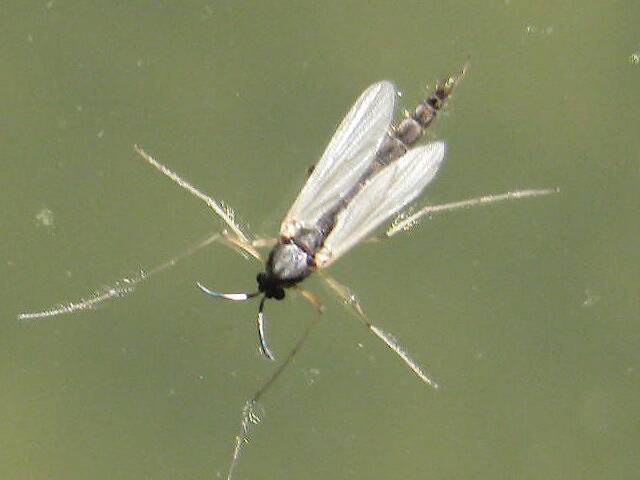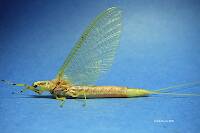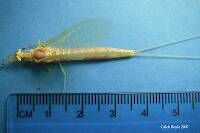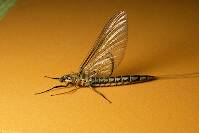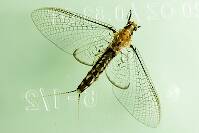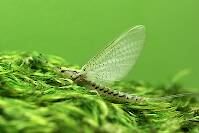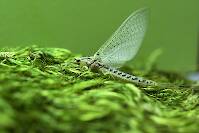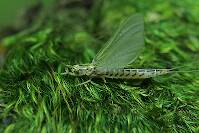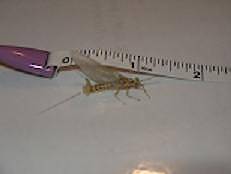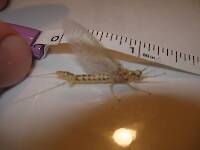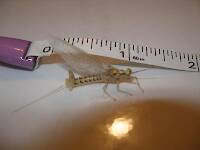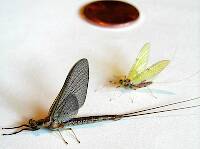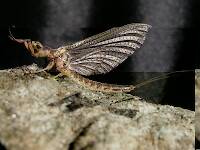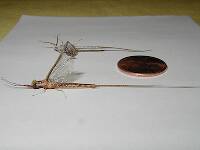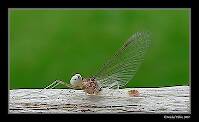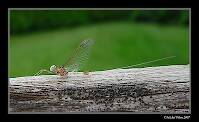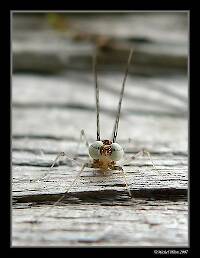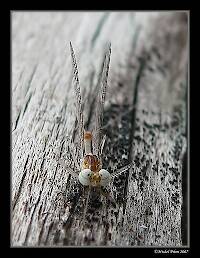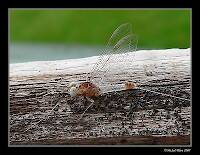
Hex Mayflies
Hexagenia limbata
The famous nocturnal Hex hatch of the Midwest (and a few other lucky locations) stirs to the surface mythically large brown trout that only touch streamers for the rest of the year.
Featured on the forum

This one seems to tentatively key to Holocentropus, although I can't make out the anal spines in Couplet 7 of the Key to Genera of Polycentropodidae Larvae nor the dark bands in Couplet 4 of the Key to Genera of Polycentropodidae Larvae, making me wonder if I went wrong somewhere in keying it out. I don't see where that could have happened, though. It might also be that it's a very immature larva and doesn't possess all the identifying characteristics in the key yet. If Holocentropus is correct, then Holocentropus flavus and Holocentropus interruptus are the two likely possibilities based on range, but I was not able to find a description of their larvae.

Troutnut is a project started in 2003 by salmonid ecologist Jason "Troutnut" Neuswanger to help anglers and
fly tyers unabashedly embrace the entomological side of the sport. Learn more about Troutnut or
support the project for an enhanced experience here.
Pilonm on Feb 27, 2012February 27th, 2012, 4:13 am EST
Hello all,
Here is the subimago of a Mayfly I photographed last May 7th, 2010 in Quebec, Canada (near Vermont).
Can we identify it? Family, genus, species?
Male or female?
If a structure is missing in order to identify it correctly, let me know as I have other pictures of the specimen, including the final exuvie.
Thank you very much in advance for your great help :)
Michel
Quebec, Canada
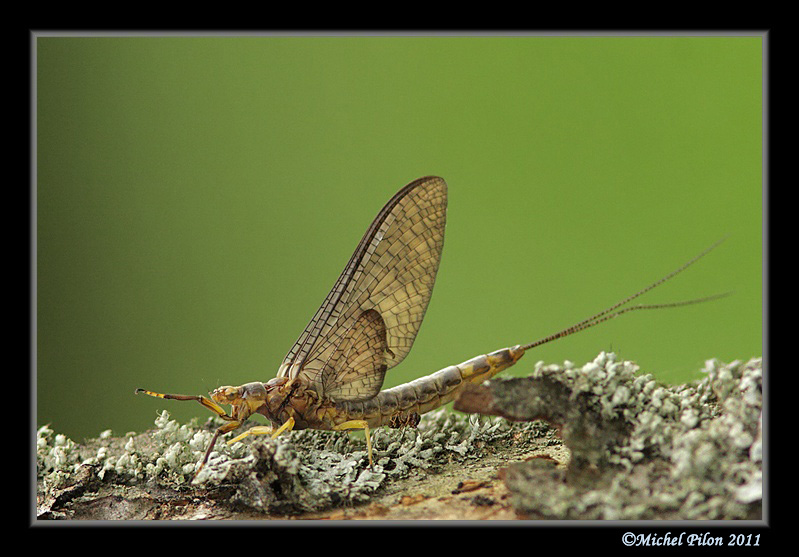
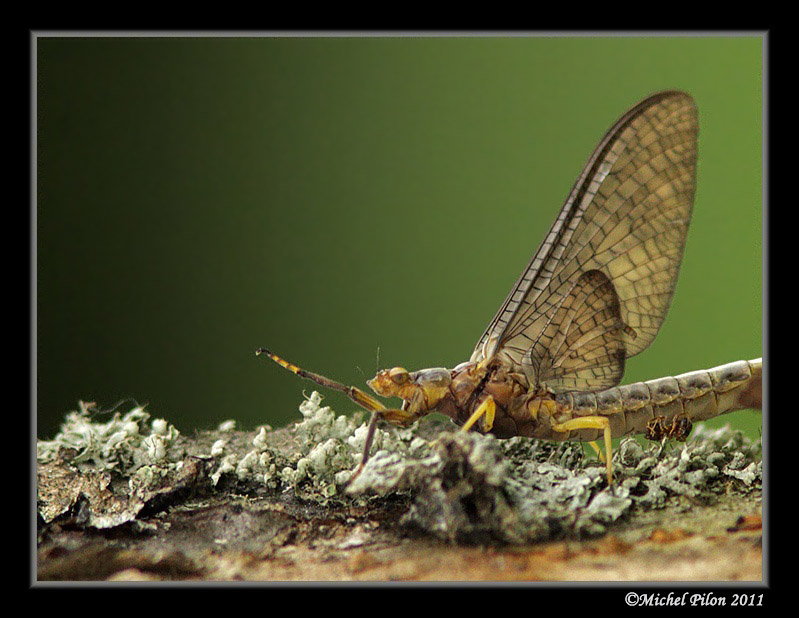
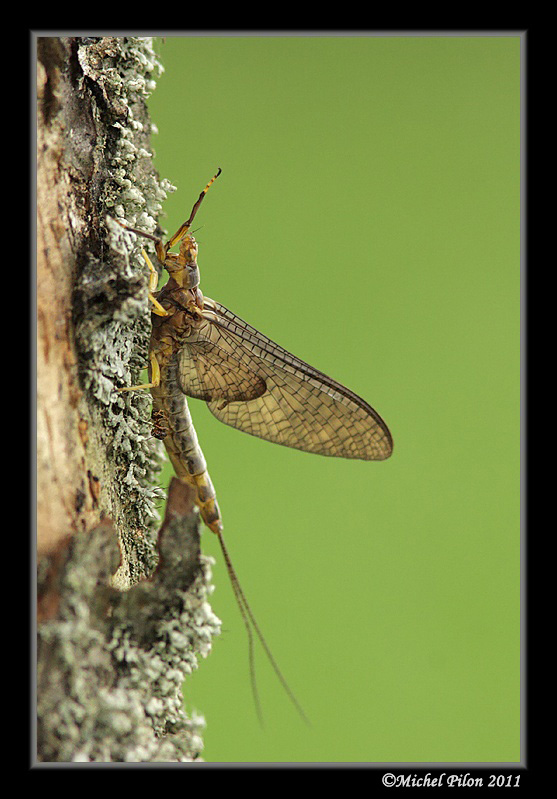
Here is the subimago of a Mayfly I photographed last May 7th, 2010 in Quebec, Canada (near Vermont).
Can we identify it? Family, genus, species?
Male or female?
If a structure is missing in order to identify it correctly, let me know as I have other pictures of the specimen, including the final exuvie.
Thank you very much in advance for your great help :)
Michel
Quebec, Canada



Oldredbarn on Feb 27, 2012February 27th, 2012, 6:56 am EST
Siphlonisca aerodromia...;) Just kidding...That one was to see if the bug boys are awake...:) Konchu,Taxon...You laughing yet?
If I had to guess...I'd say female Hex...Not sure species...This one's rather dark and May 7th...Way too early??? Odd...What was the weather like that year and where did you find it? River? Pond? Lake? Aquarium? Tomah stream? ;)
Nice photos.
Spence
If I had to guess...I'd say female Hex...Not sure species...This one's rather dark and May 7th...Way too early??? Odd...What was the weather like that year and where did you find it? River? Pond? Lake? Aquarium? Tomah stream? ;)
Nice photos.
Spence
"Even when my best efforts fail it's a satisfying challenge, and that, after all, is the essence of fly fishing." -Chauncy Lively
"Envy not the man who lives beside the river, but the man the river flows through." Joseph T Heywood
"Envy not the man who lives beside the river, but the man the river flows through." Joseph T Heywood
Entoman on Feb 27, 2012February 27th, 2012, 7:58 am EST
Hi Michel,
It looks like Hexagenia, but I believe this is possibly Litobrancha recurvata of the family Ephemeridae. It is a female dun. It is also considered the largest mayfly extant in North America.
Do you have any frontal shots? They only dependable characters I'm aware of to tell the females of this species from those in Hexagenia (unless they have been described regionally) are that the eyes are set more dorsally with less space between them, and the frons (face) extends below the eyes. In Hexagenia the frons is receded and the eyes are mounted more laterally. Older angling literature mentions differences in wing venation, color, and abdominal markings, but I believe these are now considered less reliable characters than once thought.
Regards,
Kurt
PS - Spence, I see you took your humor pill today. Or was it just too many cups of tea?:)
It looks like Hexagenia, but I believe this is possibly Litobrancha recurvata of the family Ephemeridae. It is a female dun. It is also considered the largest mayfly extant in North America.
Do you have any frontal shots? They only dependable characters I'm aware of to tell the females of this species from those in Hexagenia (unless they have been described regionally) are that the eyes are set more dorsally with less space between them, and the frons (face) extends below the eyes. In Hexagenia the frons is receded and the eyes are mounted more laterally. Older angling literature mentions differences in wing venation, color, and abdominal markings, but I believe these are now considered less reliable characters than once thought.
Regards,
Kurt
PS - Spence, I see you took your humor pill today. Or was it just too many cups of tea?:)
"It's not that I find fishing so important, it's just that I find all other endeavors of Man equally unimportant... And not nearly as much fun!" Robert Traver, Anatomy of a Fisherman
Troutnut on Feb 27, 2012February 27th, 2012, 10:00 am EST
I'm with Kurt -- it's a female dun of Litobrancha or Hexagenia, but I don't remember how to tell the difference and don't have time to look it up right now. Somebody with more experience might recognize it at a glance.
Very nice photos, by the way!
Very nice photos, by the way!
Jason Neuswanger, Ph.D.
Troutnut and salmonid ecologist
Troutnut and salmonid ecologist
Oldredbarn on Feb 27, 2012February 27th, 2012, 10:11 am EST
I've re-posted my pics of L recurvata from 2010...Pulled up the old post...I don't think its L recurvata here in Michel's pics.
Spence
Spence
"Even when my best efforts fail it's a satisfying challenge, and that, after all, is the essence of fly fishing." -Chauncy Lively
"Envy not the man who lives beside the river, but the man the river flows through." Joseph T Heywood
"Envy not the man who lives beside the river, but the man the river flows through." Joseph T Heywood
Crepuscular on Feb 27, 2012February 27th, 2012, 10:11 am EST
Michel, nice photos! I'm with you guys 99.9% sure it's Litobrancha recurvata. We have them on a couple streams near me. Cool mayfly for sure. It's one of my goals for this year to get some decent photos of this one!
Entoman on Feb 27, 2012February 27th, 2012, 11:44 am EST
Spence -
Hexagenia was my initial thinking too. The overall coloration and clouding of the hindwing margins are certainly Hexagenia traits. BTW - I agree your photos in the other thread (really good ones by the way) are Litobrancha recurvata. They fit the descriptions given in many angler-entomologies as well as the scientific lit documenting this species in MI.
The problem is I've been lead to believe color comparisons can be misleading due to the tremendous variations in appearance these two genera have subsequently been shown to exhibit and the early emergence is more in sync with recurvata. Unless a professional worker has recorded their presence in this location and described them in a paper somewhere, wer're pretty much left with using the keys like Merrit to figure it out (as best we can). The only way to tell them apart accurately is by comparing the male genitalia (not much help here), the frons, and the distance between the eyes. Another way is if we could get a good look at the scutellum, but that would require a dorsal photo with the wings open. Excepting the genitalia, the characters listed are assumed to work for females. Less dependable is the number of connections from the A1 (anal) vein of the forewing to the margin (especially if the count is low), but it's hidden by the hindwing anyway. The second photo here seems to show the frons looking to be prominent, bilobed & dipping below the eyes (which also appear to be higher set). But it is blurry when blown up, so it's hard to tell for positive. Let's hope Michel has a nice frontal. If not, perhaps a dorsal with the wings open?:)
Hexagenia was my initial thinking too. The overall coloration and clouding of the hindwing margins are certainly Hexagenia traits. BTW - I agree your photos in the other thread (really good ones by the way) are Litobrancha recurvata. They fit the descriptions given in many angler-entomologies as well as the scientific lit documenting this species in MI.
The problem is I've been lead to believe color comparisons can be misleading due to the tremendous variations in appearance these two genera have subsequently been shown to exhibit and the early emergence is more in sync with recurvata. Unless a professional worker has recorded their presence in this location and described them in a paper somewhere, wer're pretty much left with using the keys like Merrit to figure it out (as best we can). The only way to tell them apart accurately is by comparing the male genitalia (not much help here), the frons, and the distance between the eyes. Another way is if we could get a good look at the scutellum, but that would require a dorsal photo with the wings open. Excepting the genitalia, the characters listed are assumed to work for females. Less dependable is the number of connections from the A1 (anal) vein of the forewing to the margin (especially if the count is low), but it's hidden by the hindwing anyway. The second photo here seems to show the frons looking to be prominent, bilobed & dipping below the eyes (which also appear to be higher set). But it is blurry when blown up, so it's hard to tell for positive. Let's hope Michel has a nice frontal. If not, perhaps a dorsal with the wings open?:)
"It's not that I find fishing so important, it's just that I find all other endeavors of Man equally unimportant... And not nearly as much fun!" Robert Traver, Anatomy of a Fisherman
Pilonm on Mar 1, 2012March 1st, 2012, 3:04 am EST
Hello all,
First of all I would like to thank you so much for the great and so appreciated help about the identification of this Mayfly.
I found it at home where there is no lake/stream but a lot of pools (???) Maybe some very little streams at not less than 2 miles.
At 18:38, I was still photographying it on that May 7th, 2010. And in the morning I found the exuvia. So the adult emerged during the night. This subimago was very cooperative because I took a lot of pictures of it before releasing it.
The mayfly was quite big!
Here are some pictures which can be useful for identification.
Hope they can help...
Would you like a picture of the final exuvia?






Hope that helps!
Cheers,
Michel
PS. Thanks for the appreciation of the pictures,
First of all I would like to thank you so much for the great and so appreciated help about the identification of this Mayfly.
I found it at home where there is no lake/stream but a lot of pools (???) Maybe some very little streams at not less than 2 miles.
At 18:38, I was still photographying it on that May 7th, 2010. And in the morning I found the exuvia. So the adult emerged during the night. This subimago was very cooperative because I took a lot of pictures of it before releasing it.
The mayfly was quite big!
Here are some pictures which can be useful for identification.
Hope they can help...
Would you like a picture of the final exuvia?






Hope that helps!
Cheers,
Michel
PS. Thanks for the appreciation of the pictures,
Lastchance on Mar 1, 2012March 1st, 2012, 4:06 am EST
Great photos. What camera and lens did you use for the shots?
Konchu on Mar 1, 2012March 1st, 2012, 5:01 am EST
From McCafferty (1971. New genus of mayflies from eastern North America. JNYES 79:45-51.) :
I know this is a subimago, but wondering if it could be Hexagenia. The coloration of the abdomen is more like some Hexagenia than Litobrancha, the latter of which tends not to have much patterning, especially in the more lightly colored females. The Litobrancha I've seen have more staining around the wing veins, too, especially in the subimago.
You could count wing veins (see page 49, above) to be sure!
Regarding the compound eyes of the female imagos, they are unicolorous in Litobrancha...and bicolorous in Hexagenia.
I know this is a subimago, but wondering if it could be Hexagenia. The coloration of the abdomen is more like some Hexagenia than Litobrancha, the latter of which tends not to have much patterning, especially in the more lightly colored females. The Litobrancha I've seen have more staining around the wing veins, too, especially in the subimago.
You could count wing veins (see page 49, above) to be sure!
Crepuscular on Mar 1, 2012March 1st, 2012, 5:25 am EST
Wow you got some excellent shotos of this mayfly! I wish I could do that!I'm still gonna say Litobrancha, in the second set of photos, the second photo has a pretty good lateral view of the frons which extends below the eyes. That said, I've been wrong before, lots of times! And Luke you certainly have forgotten more than I'll ever know. I agree that the coloration of the abdomen makes one wonder! Here's a link to the full text McCafferty 1971: http://www.famu.org/mayfly/pubs/pub_m/pubmccaffertyw1971p45.pdf
Entoman on Mar 1, 2012March 1st, 2012, 10:13 am EST
Thank you for the frontals, Michel, they are exactly what I was hoping for. They clearly show the eyes set laterally and frons characters that clearly point to Hexagenia.
What follows is my rationale for you Michel. If the rest concur, I think you have your answer, at least as to genus:
1. Pictures of L. Recurvata are as rare as hen's teeth, but I found one here, and it is from Quebec. My concerns about the possibility of their patterning & color being different from those documented in the States look to be unfounded. http://bugguide.net/node/view/544641 Note the similarity to Spence's photo's. The prominent frons and higher set eyes are obvious. The solid brown dorsal ringed w/ yellow is also indicative of recurvata as it is a color pattern not found in any example of Hexagenia I've ever seen. Also, clouding at the hindwing margins is a common trait found in hexagenia but is unreported in Litobrancha. Since Litobrancha is monotypic, I find it puzzling that these characters aren't mentioned in the keys.
2. Though the frons in this specimen clearly pushes the envelope of the Merritt keys for Hexagenia, the descriptions for Litobrancha read as going "well below the eyes." It would be a stretch to describe this frons in that way. Fortunately, keys in The Mayflies of North and Central America, Edmunds, et al, also mention that Litobrancha frons are bilobed. This character is clearly lacking in your specimen, Michel. (Note - another troubling issue with the keys is the use of distance between the eyes to differentiate the genera. According to them, H. atrocaudata has its eyes way too close together.:))
3. Ok, if it's Hexagenia, which species is it? Of the three species reported from Quebec, H. bilineata can be eliminated over the lack of markings that appear as longitudinal striping in the hand. Of the two remaining, rigida is noted for its obvious yellow dorsal triangles, while limbata is noted for its high degree of variability and is by far the most common. Based on this I would say the specimen is most likely the latter. What is really interesting about the lateral photos is they show chevron markings pointing towards the thorax, which is very unusual. They normally point to the tails.
My opinion as to species? Hexagenia limbata.
Guys?
What follows is my rationale for you Michel. If the rest concur, I think you have your answer, at least as to genus:
1. Pictures of L. Recurvata are as rare as hen's teeth, but I found one here, and it is from Quebec. My concerns about the possibility of their patterning & color being different from those documented in the States look to be unfounded. http://bugguide.net/node/view/544641 Note the similarity to Spence's photo's. The prominent frons and higher set eyes are obvious. The solid brown dorsal ringed w/ yellow is also indicative of recurvata as it is a color pattern not found in any example of Hexagenia I've ever seen. Also, clouding at the hindwing margins is a common trait found in hexagenia but is unreported in Litobrancha. Since Litobrancha is monotypic, I find it puzzling that these characters aren't mentioned in the keys.
2. Though the frons in this specimen clearly pushes the envelope of the Merritt keys for Hexagenia, the descriptions for Litobrancha read as going "well below the eyes." It would be a stretch to describe this frons in that way. Fortunately, keys in The Mayflies of North and Central America, Edmunds, et al, also mention that Litobrancha frons are bilobed. This character is clearly lacking in your specimen, Michel. (Note - another troubling issue with the keys is the use of distance between the eyes to differentiate the genera. According to them, H. atrocaudata has its eyes way too close together.:))
3. Ok, if it's Hexagenia, which species is it? Of the three species reported from Quebec, H. bilineata can be eliminated over the lack of markings that appear as longitudinal striping in the hand. Of the two remaining, rigida is noted for its obvious yellow dorsal triangles, while limbata is noted for its high degree of variability and is by far the most common. Based on this I would say the specimen is most likely the latter. What is really interesting about the lateral photos is they show chevron markings pointing towards the thorax, which is very unusual. They normally point to the tails.
My opinion as to species? Hexagenia limbata.
Guys?
"It's not that I find fishing so important, it's just that I find all other endeavors of Man equally unimportant... And not nearly as much fun!" Robert Traver, Anatomy of a Fisherman
Entoman on Mar 1, 2012March 1st, 2012, 10:37 am EST
Ah! Thanks for the links, Luke & Eric. There'a a diagram in it of the female showing the bilobed frons I was talking about. I had my draft up working on it in bits and pieces when I had time and didn't catch your input until after I posted.
Luke -
My thoughts as well. Coupled with these latest photos showing the frons and eye placement so clearly (not to mention they're bicolorous), I don't think there's any doubt left.
Luke -
I know this is a subimago, but wondering if it could be Hexagenia. The coloration of the abdomen is more like some Hexagenia than Litobrancha, the latter of which tends not to have much patterning, especially in the more lightly colored females.
My thoughts as well. Coupled with these latest photos showing the frons and eye placement so clearly (not to mention they're bicolorous), I don't think there's any doubt left.
"It's not that I find fishing so important, it's just that I find all other endeavors of Man equally unimportant... And not nearly as much fun!" Robert Traver, Anatomy of a Fisherman
Entoman on Mar 1, 2012March 1st, 2012, 10:47 am EST
BTW - There doesn't appear to be near enough veins connecting the A1 vein to the margin for Hexagenia that isn't supposed to have less than five. I'm only seeing two, possibly three. This supports my contention that the validity of this character's use for determinations (with this group of ephemerids) is highly questionable?
"It's not that I find fishing so important, it's just that I find all other endeavors of Man equally unimportant... And not nearly as much fun!" Robert Traver, Anatomy of a Fisherman
Falsifly on Mar 1, 2012March 1st, 2012, 10:49 am EST
What is really interesting about your lateral photos is that they show chevron markings pointing towards the thorax which is very unusual. They normally point to the tails.
Yes Kurt, I find that rather interesting myself, and odd.
Falsifly
When asked what I just caught that monster on I showed him. He put on his magnifiers and said, "I can't believe they can see that."
When asked what I just caught that monster on I showed him. He put on his magnifiers and said, "I can't believe they can see that."
Oldredbarn on Mar 1, 2012March 1st, 2012, 12:13 pm EST
I'm still really puzzled by May 7th though...Like I've said before, I have my own silt bed of pet L recurvata on the Mainstream Au Sable...I see them hatching during the last two weeks of May normally. We call them, up that way, the early Hex? Strange!
Another strange thing was I didn't get any bites on this one...:)
Kurt...I think you may have hit on something here we will have to leave to the gang at Purdue :)...L recurvata was once Hexagenia recurvata and it's obvious to the naked eye that these critters are closely related...Habitat is the same etc...Maybe, for a price, I could lead Konchu to my Litobrancha farm or maybe do the right thing and send him a couple this May...How does Spencagenia recurvata sound? ;) Ha! I just wish I could get a two & a-half foot Brown to take up station below my herd! He'd be well fed.
Who knows what the DNA may tell us one day...Kissing Cousins? Maybe?
Spence
Siphlonisca aerodromia...;) Just kidding...That one was to see if the bug boys are awake...:) Konchu,Taxon...You laughing yet?
Another strange thing was I didn't get any bites on this one...:)
Since Litobrancha is monotypic, I find it puzzling that these characters aren't mentioned in the keys.
Kurt...I think you may have hit on something here we will have to leave to the gang at Purdue :)...L recurvata was once Hexagenia recurvata and it's obvious to the naked eye that these critters are closely related...Habitat is the same etc...Maybe, for a price, I could lead Konchu to my Litobrancha farm or maybe do the right thing and send him a couple this May...How does Spencagenia recurvata sound? ;) Ha! I just wish I could get a two & a-half foot Brown to take up station below my herd! He'd be well fed.
Who knows what the DNA may tell us one day...Kissing Cousins? Maybe?
Spence
"Even when my best efforts fail it's a satisfying challenge, and that, after all, is the essence of fly fishing." -Chauncy Lively
"Envy not the man who lives beside the river, but the man the river flows through." Joseph T Heywood
"Envy not the man who lives beside the river, but the man the river flows through." Joseph T Heywood
Crepuscular on Mar 1, 2012March 1st, 2012, 12:27 pm EST
Wait, I wanna get in on that! I've got my own pasture (or maybe wallow would be more appropriate) of Litobrancha. It would be really cool to see what the DNA has to say!
Entoman on Mar 1, 2012March 1st, 2012, 12:40 pm EST
Spence -
Yes, me too. That was a contributing factor to my musing regarding Litobrancha. It is supposedly the earliest ephemerid, appearing often in early May according to Edmunds. But Hexagenia that early? Who woulda thunk... Now I'm thinking about Luke's comment in that winter sulfur thread regarding biological populations having built in variation in the timing of their development. He linked an article on "abalone" I mistook for "baloney" (sorry Luke, I couldn't pass that one up). :) Weird stuff is goin' on out there!
I'm hurt, Spence. Didn't you read my first post?
I'm still really puzzled by May 7th though...
Yes, me too. That was a contributing factor to my musing regarding Litobrancha. It is supposedly the earliest ephemerid, appearing often in early May according to Edmunds. But Hexagenia that early? Who woulda thunk... Now I'm thinking about Luke's comment in that winter sulfur thread regarding biological populations having built in variation in the timing of their development. He linked an article on "abalone" I mistook for "baloney" (sorry Luke, I couldn't pass that one up). :) Weird stuff is goin' on out there!
Another strange thing was I didn't get any bites on this one...:)
I'm hurt, Spence. Didn't you read my first post?
"It's not that I find fishing so important, it's just that I find all other endeavors of Man equally unimportant... And not nearly as much fun!" Robert Traver, Anatomy of a Fisherman
Konchu on Mar 1, 2012March 1st, 2012, 1:22 pm EST
Last I checked, I could use some Litobrancha for DNA. If they're from different places, that's even better. Keep me in mind, boys.
Oldredbarn on Mar 1, 2012March 1st, 2012, 4:56 pm EST
PS - Spence, I see you took your humor pill today. Or was it just too many cups of tea?:)
Oh yeah...I did see that, sorry. :)
Last I checked, I could use some Litobrancha for DNA. If they're from different places, that's even better. Keep me in mind, boys.
Luke...I usually get a chance to check on the herd in May...Maybe opening day weekend...Last Sat in April. I'll have to dig out the old entomology set and see what I can do.
Spence
"Even when my best efforts fail it's a satisfying challenge, and that, after all, is the essence of fly fishing." -Chauncy Lively
"Envy not the man who lives beside the river, but the man the river flows through." Joseph T Heywood
"Envy not the man who lives beside the river, but the man the river flows through." Joseph T Heywood
Quick Reply
Related Discussions
Topic
Replies
Last Reply
1
Aug 1, 2008
by Troutnut
by Troutnut
3
May 31, 2016
by Oldredbarn
by Oldredbarn
10
Jun 30, 2009
by Jmd123
by Jmd123
5
Oct 17, 2007
by Pilonm
by Pilonm







